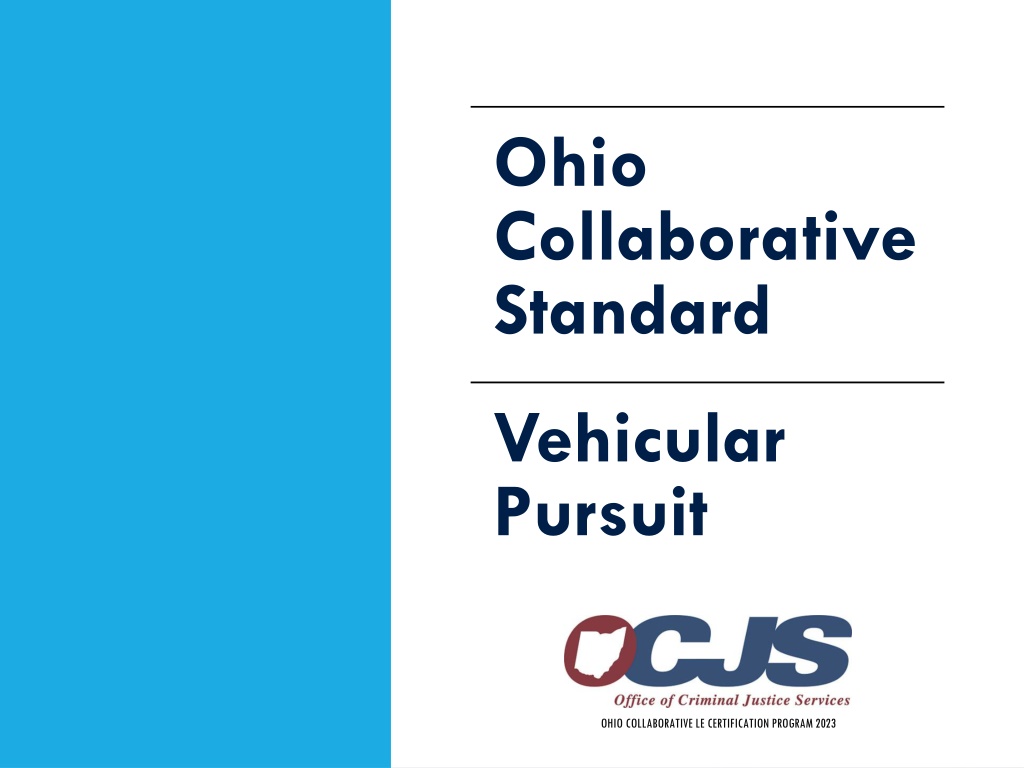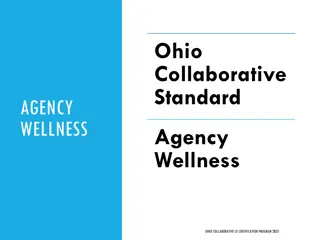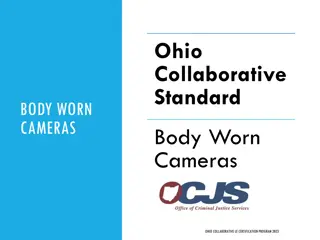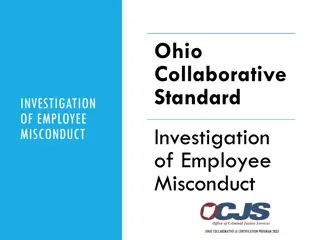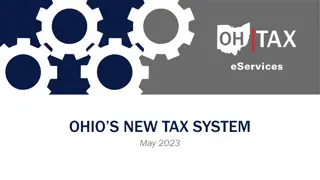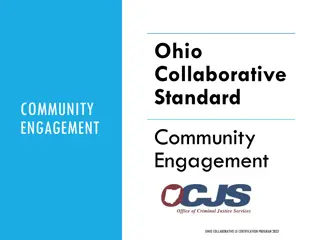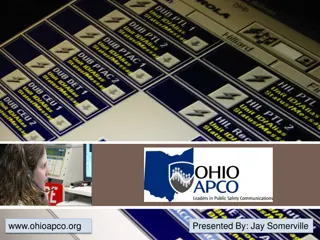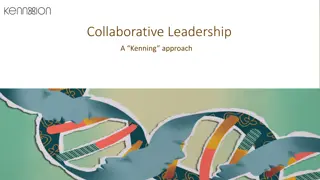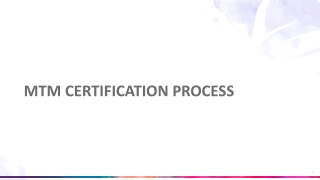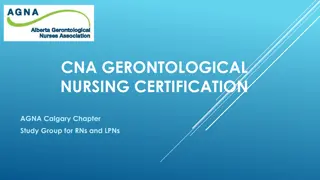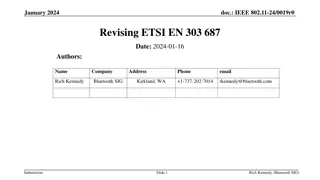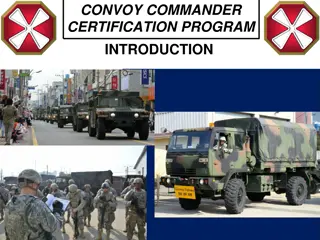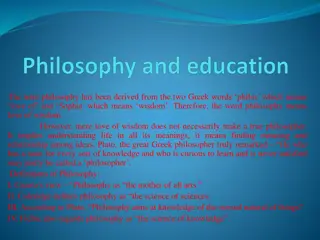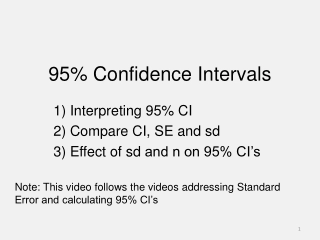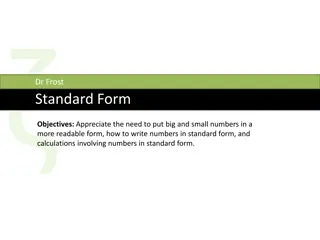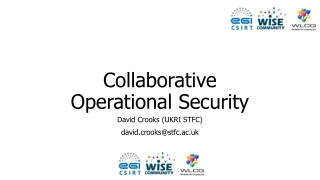Ohio Collaborative Standard for Vehicular Pursuit Certification Program 2023
The Ohio Collaborative Community-Police Advisory Board adopted the State of Ohio Standard for Vehicular Pursuit in 2020 to address the risks and dangers associated with vehicle pursuits. This standard aims to govern law enforcement agencies in defining pursuits, criteria for initiation, evaluating circumstances, and outlining responsibilities of units involved to enhance safety for officers and the public.
Download Presentation
Please find below an Image/Link to download the presentation.
The content on the website is provided AS IS for your information and personal use only. It may not be sold, licensed, or shared on other websites without obtaining consent from the author. Download presentation by click this link. If you encounter any issues during the download, it is possible that the publisher has removed the file from their server.
Presentation Transcript
Ohio Collaborative Standard Vehicular Pursuit OHIO COLLABORATIVE LE CERTIFICATION PROGRAM 2023
Learning Objectives Vehicular Pursuit Standard: Purpose Standard LEARNING OBJECTIVES Commentary Model Policy Compliance
VEHICULAR PURSUIT The ability of the police to perform their duties is dependent upon public approval of police actions. -Sir Robert Peel (1829)
VEHICULAR PURSUIT 21st Century Policing 1.6.1 Action Item: Research conducted to evaluate the effectiveness of crime fighting strategies should look at the potential for collateral damage of any given strategy on community trust and legitimacy.
VEHICULAR PURSUIT In 2020, The Ohio Collaborative Community-Police Advisory Board adopted the State of Ohio Standard for Vehicular Pursuit.
VEHICULAR PURSUIT Purpose: Vehicle pursuits are dangerous and pose a high risk for officers and the community. Both law enforcement personnel and the general public will benefit from a Law Enforcement Vehicular Pursuit Standard.
VEHICULAR PURSUIT Standard: Law enforcement agencies shall establish a written policy that governs the pursuit of motor vehicles. The policy, at a minimum, shall include the following: Definition of a motor vehicle pursuit; Defining the criteria under which a pursuit can be initiated;
VEHICULAR PURSUIT Standard (continued): Evaluating the circumstances (seriousness of the alleged offense, conditions of the road and location of the pursuit, time of day and weather conditions); A provision that prohibits or discourages pursuits when the suspect is known to the officers or easily identifiable, unless the officers have probable cause to believe the suspect s escape poses a significant threat of death or serious physical injury to officers or others; Responsibilities of the initiating unit and secondary units;
VEHICULAR PURSUIT Standard (continued): Specifying the roles and restrictions pertinent to marked, unmarked, or other types of police vehicle involvement in the pursuit; Provide communication protocols addressing responsibilities for officers and telecommunicators; Describing supervisors responsibilities; Specifying when and who has the authority to terminate pursuit; Engaging in inter and intra-jurisdictional pursuits involving personnel from the agency and/or other jurisdictions;
VEHICULAR PURSUIT Standard (continued): A requirement that agencies provide training to officers prior to the utilization of pursuit termination tactics and intervention techniques (e.g. PIT maneuver, tire deflation devices, road-blocks, etc.); Requiring a written report and an administrative review of each pursuit; and Conducting a documented annual analysis of pursuit reports, to include a review of policy and reporting procedures, approved by the head of the agency (the annual analysis should be interpreted as an annual review).
VEHICULAR PURSUIT Standard Commentary Due to extreme danger that these pursuits present, many agencies have limited the circumstances in which they will allow their officers to engage in pursuits. Some agencies have prohibited pursuits or limited them to rare circumstances. Agencies should have explicit policies and procedures for pursuits. All sworn personnel should be provided these policies. Agencies should have frequent discussions/briefings/trainings about these directives.
VEHICULAR PURSUIT Standard Commentary (continued): Because of the inherent risk, agencies should seek to limit the use of vehicular pursuits. Pursuits should be terminated whenever the level of danger created by the pursuit outweighs the immediate consequences of the suspect s escape.
VEHICULAR PURSUIT Vehicular Pursuit Model Policy Purpose: A respect for human life shall guide officers in determining whether to engage in or terminate a vehicular pursuit. Officers shall act within the boundaries of legal guidelines and agency policy when engaging in pursuits. Officers shall terminate a pursuit if the immediate danger of initiating or continuing the pursuit is greater than the immediate or potential danger to the public if the suspect remains at large.
VEHICULAR PURSUIT Vehicular Pursuit Model Policy Definitions: The following definitions are included in the sample policy. Please refer to the sample policy, located on the Ohio Collaborative website for any clarification. -Vehicle pursuit -Discontinuation or Abandonment of Pursuit -Termination of a Pursuit -Blocking or Vehicle Intercept -Boxing In -Pursuit Trailing -Precision Immobilization Techniques (PIT) -Ramming -Roadblocks -Tire Deflation Device, Spikes or Tack Strips
VEHICULAR PURSUIT Vehicular Pursuit Model Policy Procedures: Officer Responsibilities- It is the policy of this department that a vehicle pursuit shall be conducted with at least one red or blue flashing, rotating, or oscillating light, visible under normal atmospheric conditions from a distance of 500 feet to the front of, and a siren activated on an authorized public safety vehicle (ORC 4511.37, ORC 4513.21, ORC 4511.01 (E)(2), ORC 4511.041 and ORC 4511.24) The following policy is established to provide officers with guidelines for driving with due regard and caution for the safety of all persons using the highway.
VEHICULAR PURSUIT Vehicular Pursuit Model Policy When to initiate a Pursuit: Officers are authorized to initiate a pursuit when it is reasonable to believe that a suspect is attempting to evade arrest or detention by fleeing in a vehicle that has been given a signal to stop by a peace officer. (ORC 2921.331 (B) and ORC 2935.03 (D)). Factors to consider: Seriousness of the known or reasonably suspected crime and its relationship to community safety. Property crimes do not justify a pursuit. The importance of protecting the public and balancing the known or reasonably suspected offense and the apparent need for immediate capture against the risks to all. The apparent nature of the fleeing suspect (e.g. whether the suspect represents a serious threat to public safety). Officer should recognize that if the suspect can be apprehended at a later time, it may not be prudent to continue pursuit.
VEHICULAR PURSUIT Vehicular Pursuit Model Policy When to initiate a Pursuit (continued): The safety of the public in the area of the pursuit, including the type of area, time of day, the amount of vehicular and pedestrian traffic (e.g. school zones) and the speed of the pursuit relative to these factors. The pursuing officer s familiarity with the area of the pursuit, the quality of radio communication between the pursuing units and the dispatcher/supervisor, and the driving capabilities of the pursuing officers under the conditions of the pursuit. The weather, traffic and road conditions that unreasonably increase the danger of the pursuit when weighed against the risks resulting from the suspect s escape. The performance capabilities of the vehicles used in the pursuit in relation to the speed and other conditions of the pursuit. Vehicle speeds and evasive tactics of the suspect. Length of the pursuit.
VEHICULAR PURSUIT Vehicular Pursuit Model Policy When to initiate a Pursuit (continued): The availability of other resources, such as aircraft assistance. If the police vehicle is carrying passengers, (prisoners, ride- along, etc.) they should not be authorized to participate in the pursuit. Additional factors should be considered when pursuing motorcycles or like vehicles, due to the propensity for injury.
VEHICULAR PURSUIT Vehicular Pursuit Model Policy When to terminate a pursuit: Officers and supervisors must continuously weigh the seriousness of the offense against the potential danger to innocent motorists, themselves and the public when electing to continue a pursuit. The following factors on when to initiate a pursuit are expressly included herein and will apply equally to the decision to discontinue as well as the decision to initiate a pursuit. Pursuits should be discontinued whenever the totality of the circumstances known or which reasonably ought to be known to the officer or supervisor during the pursuit indicates that the present risk of continuing the pursuit reasonably appears to outweigh the risk resulting from the suspect s escape. Operating an emergency vehicle in a pursuit with emergency lights and siren does not relieve the operator of an authorized emergency vehicle of the duty to drive with due regard for the safety of all persons and does not protect the driver from the consequences of his/her reckless disregard for the safety of others (ORC 4511.45(B)).
VEHICULAR PURSUIT Vehicular Pursuit Model Policy When to terminate a pursuit (continued): In addition to the factors listed above, the following factors should be considered when deciding whether to terminate a pursuit: The distance between the pursuing officers and the fleeing vehicle is so great that further pursuit would be futile or require the pursuit to continue for an unreasonable time or distance. The pursued vehicle s location is no longer known. The law enforcement vehicle sustains damage or a mechanical failure that renders it unsafe to drive, or the pursuit vehicle suffers an emergency equipment failure that causes the vehicle to no longer qualify for emergency operation use. Pursuits for misdemeanors not involving physical abuse or risk of serious harm should be discouraged.
VEHICULAR PURSUIT Vehicular Pursuit Model Policy When to terminate a pursuit (continued): The potential hazards to uninvolved bystanders or motorists. When the identity of the offender is known and it does not reasonably appear that the need for immediate capture outweighs the risk associated with continuing the pursuit, officers should strongly consider discontinuing the pursuit and apprehending the offender at a later time. When directed to terminate the pursuit by a supervisor.
VEHICULAR PURSUIT Vehicular Pursuit Model Policy Pursuit Vehicles: Pursuit units should be limited to three vehicles (two units and a supervisor). (the number may vary with circumstances) Pursuits by law enforcement unmarked vehicles and motorcycles should be highly discouraged. Vehicles not equipped with lights and sirens are prohibited from pursuits. Pursuing law enforcement vehicles must meet the requirements of ORC 4511.24 in-regard to lights, audible signals, and due regard for safety. If unmarked vehicles/motorcycles initiate the pursuit, they should relinquish the pursuit to marked vehicles at the earliest opportunity. Officers in such vehicles may provide support to pursuing units as long as the vehicle is operated in compliance with all traffic laws (ORC 4511.041 and ORC 4513.21).
VEHICULAR PURSUIT Vehicular Pursuit Model Policy Pursuit Vehicles (continued): An officer may request additional units to join a pursuit after assessing the factors outlined above, as it appears that the number of officers involved would be insufficient to safely arrest the suspect. This request must be approved by a supervisor, absent exigent circumstances. All other officers shall stay out of the pursuit but should remain alert to its progress and location. Any officer who drops out of a pursuit may then, if necessary, proceed to the termination point at safe speeds, following the appropriate rules of the road.
VEHICULAR PURSUIT Vehicular Pursuit Model Policy Primary Unit Responsibilities: The initial pursuing officer will be designated as the primary unit and will be responsible for the conduct of the pursuit unless they are unable to remain reasonably close enough to the violator s vehicle. The primary responsibility of the initiating officer is the apprehension of the suspect without unreasonable danger to all. Officers should continuously update information to allow supervisor(s) to sufficiently assess continuation of the pursuit. Unless circumstances indicate otherwise, broadcasting the pursuit to a secondary unit.
VEHICULAR PURSUIT Vehicular Pursuit Model Policy Primary Unit Responsibilities (continued): Primary Unit radio traffic includes: The reason for the pursuit. The location and direction of travel. Pursuit speed. The description of the fleeing vehicle and license number, if known. The number of occupants. The identity or description of the known occupants. The identity of other agencies involved in the pursuit. Information concerning the use of firearms, threat of force, injuries, hostages or other unusual hazards. When the pursued vehicle is lost, the primary unit should broadcast pertinent information to assist other units in locating the vehicle. The primary unit will be responsible for coordinating any further search for pursued vehicle/suspect on foot.
VEHICULAR PURSUIT Vehicular Pursuit Model Policy Secondary Unit Responsibilities: Immediate notifying the dispatcher of his/her entry into the pursuit. Providing back up to the primary unit. Ensuring that Dispatch notifies nearby jurisdictions. Remaining at a safe distance behind the primary unit unless directed to assume the role of primary officer, or if the primary unit is unable the situation indicates otherwise. Responding to the point where the pursued vehicle has been stopped. Ensure that available BWCs and/or in-car video are activated. Sharing responsibility to initiate or discontinue the pursuit with the initiating officer. Coordinating all aspects of the pursuit, including the number of units and any further search for pursued vehicle/suspect on foot.
VEHICULAR PURSUIT Vehicular Pursuit Model Policy Supervisory Control and Responsibilities: The on-duty supervisor has the final responsibility for the coordination, control and termination of a vehicle pursuit. It is recommended, when possible, that the on-duty supervisor not engage in the pursuit, in order to maintain objectivity. The supervisor s decision to discontinue the pursuit is final. Upon becoming aware of a pursuit, immediately notifying involved officers and dispatch of supervisory presence and ascertaining all reasonably available information, and continuously assess the situation and risk factors associated with the pursuit in order to ensure that the pursuit is conducted within established agency guidelines. Ensuring that no more than the number of required law enforcement units needed are involved in the pursuit. Directing that the pursuit be terminated if continuation of the pursuit is not justified. Ensuring that aircraft assistance is requested, if available. Ensure proper radio channel/traffic and notification of outside agencies of the pursuit. Control and manage units. Prepare a post-pursuit critique and review of the pursuit for training purposes. Review of pertinent reports for content and forward through the Chain of Command.
VEHICULAR PURSUIT Vehicular Pursuit Model Policy Dispatcher Responsibilities: Upon notification that a pursuit has been initiated, Dispatch will be responsible for: Ensuring that a supervisor is assigned to direct and manage the pursuit. Ensuring that the supervisor is fully informed of the stated reason and pursuit conditions. Properly documenting all pursuit activities. Query available information and broadcast pertinent information, as necessary. Communicating and coordinating with surrounding jurisdictions.
VEHICULAR PURSUIT Vehicular Pursuit Model Policy Pursuit Driving Tactics: The decision to use specific driving tactics requires the same assessment of considerations outlined in the factors to be considered concerning pursuit initiation and termination. The following are tactics for units involved in the pursuit: Pursuing officers should place their vehicles in such a manner as to afford them the ability to see and avoid hazards or react safely to maneuvers by the fleeing vehicle. Because intersections present increased risks: Available units not directly involved may proceed safely to controlled intersections ahead of the pursuit to warn traffic. Pursuing units should exercise due caution through intersections. Officers may proceed past a red or stop signal/stop sign but only after slowing down for safe operation (ORC 4511.03). Notify OSP or other jurisdictions of pursuit coming into their jurisdiction. Do not pass other involved units unless situation dictates or otherwise instructed.
VEHICULAR PURSUIT Vehicular Pursuit Model Policy Tactics/Procedures for units not involved in the pursuit: Officers should not engage in pursuits by other jurisdictions unless requested by pursuing agency and approved by a supervisor. Do not parallel the pursuit route. Officers are authorized to use emergency equipment at intersections along the pursuit path to clear vehicular/pedestrian traffic to protect the public. Officers should not become involved with the pursuit unless otherwise directed by a supervisor. Non-pursuing personnel needed after the pursuit should respond non- emergency. Only assigned units should respond under emergency conditions. Pursuit Trailing: The initiating unit that releases control to another unit may follow the pursuit with permission of the supervisor.
VEHICULAR PURSUIT Vehicular Pursuit Model Policy Aircraft Assistance: Use aircraft assistance when possible. The aircraft assistance will take over control of the pursuit. The aircraft assistance should direct personnel, inform supervision and recommend termination if appropriate. Jurisdictional Considerations: The primary officer, or supervisor, should determine based on circumstances whether they need assistance from the agency who has jurisdiction where the pursuit is travelling into. All agencies will speak in plain English instead of radio code to better communicate.
VEHICULAR PURSUIT Vehicular Pursuit Model Policy Pursuits Initiated by Another Agency: The agency that initiates a pursuit shall be responsible for conducting the pursuit. Officers should not join a pursuit unless specifically requested to do so by the agency who's in pursuit. The exceptions to this are: When a single unit from the initiating agency is in pursuit, a unit from this agency may join the pursuit. When an actual or suspected felon who reasonably appears a serious threat to the public if not apprehended is being pursued, a supervisor may authorize officers to join the pursuit. When a request is made to assist or take over a pursuit from another agency that has entered this jurisdiction, the supervisor should consider these additional factors: Ability to maintain the pursuit. Circumstances serious enough to continue the pursuit. Adequate staffing to continue the pursuit. The public s safety within this jurisdiction. Safety of the pursuing officers.
VEHICULAR PURSUIT Vehicular Pursuit Model Policy Pursuits Initiated by Another Agency (continued): As soon as practical, supervisors should review requests for assistance from other agencies. Supervisors may decline requests based on the above circumstances. Assistance will normally terminate these pursuits at the city limits. In the event the pursuit terminates within this jurisdiction, officers shall offer assistance including, but not limited to: scene control, coordination and completion of supplemental reports and any other assistance requested or needed.
VEHICULAR PURSUIT Vehicular Pursuit Model Policy Assumption of Pursuit by Another Agency: Agencies will discontinue the pursuit when another agency has assumed the pursuit, unless continued assistance of the agency is requested by the primary agency assuming the pursuit. Upon discontinuing, the primary unit may proceed upon request to the termination point with supervisory approval. The role and responsibilities of officers at the termination of a pursuit initiated by this agency shall be coordinated with appropriate consideration of the units from the agency assuming the pursuit. Notification of a pursuit in progress should not be considered a request to join the pursuit. Requests to or from an agency to assume assistance in a pursuit should be specific. Any requests from another agency should be considered to mean the agency will assume responsibility for the pursuit, and similarly when requesting assistance in another jurisdiction this agency will be relinquishing responsibility.
VEHICULAR PURSUIT Vehicular Pursuit Model Policy Intervention/Alternatives to Stopping the Fleeing Vehicle: Pursuit intervention is an attempt to terminate the ability of a suspect to continue to flee in a motor vehicle through tactical application of technology, tire deflation devices, blocking, boxing, PIT (Precision Immobilization Techniques), ramming or roadblock procedures. When Intervention is Authorized: Absent exigent circumstances, use of pursuit intervention tactics should be employed only after supervisory approval. This usage should be weighed between the risk of the pursuit continuing or hazards of each tactic. The decision should be reasonable in light of circumstances apparent to the officer at the time of the decision. Members will act within legal bounds using good judgment and accepted practices.
VEHICULAR PURSUIT Vehicular Pursuit Model Policy Pursuit Intervention Tactics: Any intervention tactics may present dangers to the officers and the public. Certain applications may be considered a use of force, including deadly force, and should follow agency policies. Officers shall consider these facts and requirements prior to deciding how, when, where and if an intervention tactic should be employed. 1. Blocking or vehicle intercept should only be considered in cases involving felony suspects or impaired drivers who pose a significant threat to public safety, and when officers reasonably believe that attempting a conventional enforcement stop will likely result in the driver attempting to flee in the vehicle. Because of the potential risk involved, this technique should only be employed by officers who have received training in such tactics and after giving consideration to the following: a. The need to immediately stop the driver substantially outweighs the risk of injury or death to occupants of the suspect vehicle, officers or public. b. All other reasonable techniques have failed or appear ineffective. c. Employing the blocking maneuver does not unreasonably increase the risk to officer safety. d. The target vehicle is stopped or traveling at a low speed. e. At no time should civilian vehicles be used to deploy this technique.
VEHICULAR PURSUIT Vehicular Pursuit Model Policy Pursuit Intervention Tactics (continued): 2. Only those officers trained in the use of the PlT will be authorized to use this procedure and only then with approval of a supervisor (if feasible) upon consideration of the circumstances and conditions presented at the time, including the potential for injury to others, the public and occupants of the pursued vehicle. 3. Intentional contact-Ramming a fleeing vehicle should be done only after other reasonable tactical means at the officer s disposal have been exhausted. This tactic should be reserved for situations where there does not appear to be another reasonable alternative method. This policy is an administrative guide to direct officers in their decision-making process before ramming another vehicle. When ramming is used as a means to stop a fleeing vehicle, one or more of the following factors should be present: The suspect is an actual or suspected felon who reasonably appears to represent a serious threat to the public if not apprehended. The suspect is driving with willful or wonton disregard for the safety of other persons or is driving in a reckless and life-endangering manner. If there does not appear to be a present/immediate serious threat to the public, ramming is not authorized.
VEHICULAR PURSUIT Vehicular Pursuit Model Policy Pursuit Intervention Tactics (continued): 4. As with all intervention techniques, pursuing officers should obtain supervisor approval before attempting to box a suspect vehicle during a pursuit. The use of such a technique must be carefully coordinated with all involved units, taking into consideration the circumstances and conditions apparent at the time, as well as the potential risk of injury to officers, the public and occupants of the pursued vehicle. 5. Tire Deflation Devices may be authorized under the following circumstances: 6. With approval of a supervisor (if feasible) Evaluation of the circumstances and conditions presented at the time, including the potential for injury to others, the public and occupants of the pursued vehicle. Tire deflation devices should only be deployed when it is reasonably apparent that only the pursued vehicle will be affected by their use. Prior to the deployment of stop sticks, the officer should notify pursuing units and the supervisor of the intent and location. Officers should carefully consider the limitations of such devices as well as the potential risks to all. If the pursued vehicle is a motorcycle, three-wheeled vehicle, all-terrain vehicle, a vehicle transporting hazardous materials or a school bus transporting children, officers and supervisors should weigh the potential consequences against the need for immediate stoppage of the vehicle.
VEHICULAR PURSUIT Vehicular Pursuit Model Policy Pursuit Intervention Tactics (continued): 7. The use of roadblocks for stopping fleeing offenders may be used under the following circumstances: Based on safety-If a roadblock will expose any person to a clear and unreasonable risk of injury, it shall not be used. The risk of safety to the public must be the determining factor. The risk of continuing a pursuit must be greater than the risk of deploying roadblock tactics. The type of fleeing vehicle should be considered. If the fleeing vehicle is a motorcycle, all-terrain vehicle, or similar, a roadblock should be avoided. If other traffic is affected, the roadblock must be established in an area that allows other traffic ample warning to identify the roadblock and stop within a safe distance. The roadblock should be constructed in such a manner as to leave a route through the area, but designed to force vehicles to slow down considerably in order to proceed. Stationary roadblocks will be located in an area which provides safe stopping distance for traffic. Officers should place themselves in a position of safety, as well as tactically available to make apprehension of the suspect if the vehicle does stop. All patrol vehicles used or adjacent to the pursuit should have emergency lights activated.
VEHICULAR PURSUIT Vehicular Pursuit Model Policy Pursuit Intervention Tactics (continued): 8. Supervisor considerations related to roadblocks: Decide what type of roadblock to use, if any. Provide direction and control with safety being the primary concern. Be aware of existing conditions such as traffic volume, type of area, availability of back-up officers, and nature of the violation. 9. Constitutional requirements and deadly force policy should be considered when using firearms to terminate a pursuit. Shooting at, or from moving vehicles increases the risk of injury to others, may be prohibited.
VEHICULAR PURSUIT Vehicular Pursuit Model Policy Post Pursuit Reporting and Review: All reports shall be completed to comply with local and state regulations. The primary officer shall complete appropriate crime/arrest reports and complete summary of the pursuit. The officer and/or supervisor shall complete a memorandum summarizing the pursuit to the CEO. The following should be included, at a minimum: Date/Time Length of pursuit in distance and time. Involved units and officers. Initial reason and circumstances surrounding the pursuit. Starting/termination points. Alleged offense, charges filed or disposition; arrest, citation, or other release. Arrestee information should be provided if applicable. Injuries and/or property damage. Medical treatment if any. Outcome of the pursuit. Name of supervisor(s).
VEHICULAR PURSUIT Vehicular Pursuit Model Policy Post Pursuit Reporting and Review (continued): A preliminary determination that the pursuit appears to be in compliance with this policy or that additional review and/or follow-up is warranted. All units involved directly or indirectly in this pursuit shall complete a written report documenting their actions in the pursuit. After receiving copies of reports, logs and other pertinent information, the CEO shall conduct or assign the completion of a post-pursuit review as appropriate to the circumstances. Ensure collection of all available audio and video recordings are retained for evidentiary value.
VEHICULAR PURSUIT Vehicular Pursuit Model Policy Regular and Periodic Pursuit Training: All officers should be provided periodic training on this vehicle pursuit policy, best practices and safe driving techniques. Training will include a recognition of the need to balance the known offense and the need for immediate capture against the risks to officers and others. Training officers and administrators should consider the use of the Ohio Peace Officers Training Academy s judgmental driving simulators.
VEHICULAR PURSUIT Vehicular Pursuit Model Policy Policy Review and Analysis: At least annually, sworn member shall review and complete an acknowledgement (Read & Sign) for this policy. A documented annual analysis of pursuit reports, to include a review of this policy and reporting procedures, shall be conducted at the direction of the Chief/Sheriff. *For intent of this standard, an analysis should be considered a review*
VEHICULAR PURSUIT Vehicular Pursuit Annual Compliance: Current year report and/or administrative review of a pursuit (bullet B) Current year training records (bullet C) Annual review (bullet D) Current year read and sign (bullet E)
VEHICULAR PURSUIT Ohio Collaborative Annual Pursuit Standard Review The intent of any Ohio Collaborative Annual Review is to : Review policy and reporting procedures to determine if agency needs are being met; Review patterns and trends with any data collected; Review training needs if any; Review equipment needs if any; This information is crucial in assisting the CEO and command staff with making informed decisions for agencies. Each agency has unique challenges and circumstances in providing their citizens with the best service possible. Ensure your agency is using this template, and any other information gathering deemed necessary by the agency, to ascertain best results.
